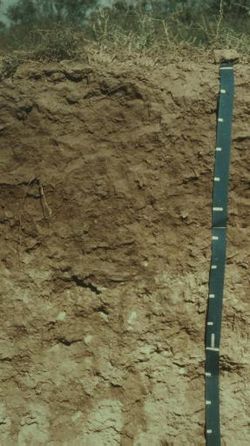Top Qs
Timeline
Chat
Perspective
Aridisol
Dry soil From Wikipedia, the free encyclopedia
Remove ads
Aridisols (or desert soils) are a soil order in USDA soil taxonomy.[1] Aridisols (from the Latin aridus, for "dry", and solum) form in an arid or semi-arid climate. Aridisols dominate the deserts and xeric shrublands, which occupy about one-third of the Earth's land surface. Aridisols have a very low concentration of organic matter, reflecting the paucity of vegetative production on these dry soils. Water deficiency is the central defining characteristic of Aridisols. Also required is sufficient age to exhibit subsoil weathering and development. Limited leaching in aridisols often results in one or more subsurface soil horizons in which suspended or dissolved minerals have been deposited: silicate clays, sodium, calcium carbonate, gypsum, or soluble salts. These subsoil horizons can also be cemented by carbonates, gypsum, or silica. Accumulation of salts on the surface can result in salinization.
This article includes a list of general references, but it lacks sufficient corresponding inline citations. (July 2013) |
In the World Reference Base for Soil Resources (WRB), most Aridisols belong to the Calcisols, Gypsisols, Durisols and Solonchaks.[2]
- Aridisols of the world
- Some Aridisols are found in oases
- Other Aridisols are observed in areas where the steppe passes into the semi-desert, such as in the lower Volga region
Remove ads
See also
References
Wikiwand - on
Seamless Wikipedia browsing. On steroids.
Remove ads




